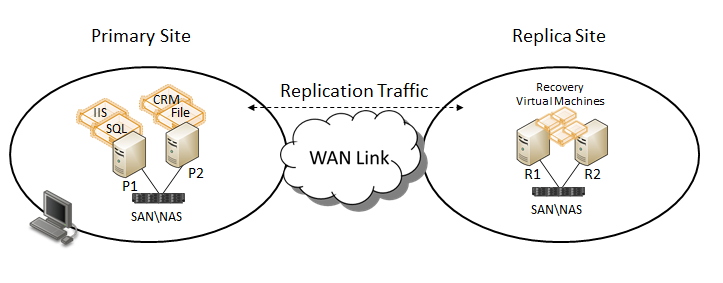Hyper-V VM Replications Test
Hyper-V Replica enables organizations to implement an affordable Business Continuity and Disaster Recovery (BCDR) solution for virtualized workloads. This allows virtual machines running at a primary site to be efficiently replicated to secondary location (Replica site) across a WAN link.

Figure 1 : How Hyper-V Replica works
Delays/errors in the replication process can cause a severe data non-sync between the primary and secondary sites, resulting in significant loss of data when disaster strikes and recovery is attempted. To protect the data from loss, you need to monitor the replication machinery continuously, and on the slightest sign of a disturbance, alert the relevant administrators and ensure that the anomaly is promptly remediated. The Hyper-V VM Replication test does just that. This test monitors the replication activity performed by Hyper-V Replica for each VM on a Hyper-V host, instantly detects latencies or inconsistencies in the process, and proactively warns administrators of the same, so that the necessary corrective/control action can be taken.
Note:
This test will report metrics for Microsoft Hyper-V Server 2012 only.
Target of the test : A Hyper-V / Hyper-V VDI server
Agent executing the test : An internal agent
Output of the test : One set of results for each VM on a Hyper-V host monitored
| Parameter | Description |
|---|---|
|
Test period |
This indicates how often should the test be executed. |
|
Host |
Specify the HOST for which this test is to be configured. |
| Measurement | Description | Measurement Unit | Interpretation |
|---|---|---|---|
|
Average replication latency |
Indicates the average time taken to replicate this VM to another host. |
Secs |
A low value is desired for this measure. Typically, replication is said to be ‘Normal’ if latency is less than 5 minutes. A high value indicates that too much time is taken for replicating a VM. This could be owing to network connectivity issues, storage issues on the primary or replica or if the primary VM requires resynchronization. This is a cause for concern, as it can cause significant data loss at the time of a fail-over. To identify the VM that is taking the maximum time to replicate, compare the value of this measure across VMs. |
|
Average replication size |
Indicates the average size of the replication files related to this VM. |
MB |
If large sized files are transferred over the network as part of a replication activity, it is bound to consume more bandwidth and even delay the replication process. A low value is hence desired for this measure per VM. To find out which VM’s replica contains files of the maximum size, compare the value of this measure across VMs. |
|
Compression efficiency |
Indicates the percentage compression efficiency for the files that have been transferred over the network when replicating this VM. |
Percent |
Higher the value of this measure, greater the compression efficiency. This in turn implies optimal bandwidth usage over the network. A low value hence indicates that too much bandwidth is used when transferring replicated files over the network. Its good practice to configure Hyper-V Replica to compress the data transmitted over the network in the settings for the virtual machine in Hyper-V Manager. You can also use tools outside of Hyper-V to perform compression. |
|
Last replication size |
Indicates the size of the files replicated for this VM during the last replication. |
MB |
|
|
Network data received |
Indicates the data received for this VM over the network since the virtual machine management service was started. |
MB |
|
|
Network data sent |
Indicates the data sent for this VM over the network since the virtual machine management service was started. |
MB |
|
|
Replication count |
Indicates the number of replication cycles that have run for this VM since the virtual machine management service was started. |
Number |
|
|
Replication latency |
Indicates the last replication latency of this VM. |
Secs |
It is the time taken for the delta to be applied on the recovery since it was snapped. A low value is desired for this measure. |
|
Resynchronized data |
Indicates the data sent and received over the network for this VM during the resynchronize operation since the virtual machine management service was started. |
MB |
A resynchronization essentially compares blocks between the Primary and Replica VHDs and then sends the delta blocks to the Replica. Scenarios where this can happen include, but may not be limited to, a failure occurred on the Primary server when changes were being made to the replication log or, if the Primary is a Failover Cluster, an unplanned cluster failover occurred. |



